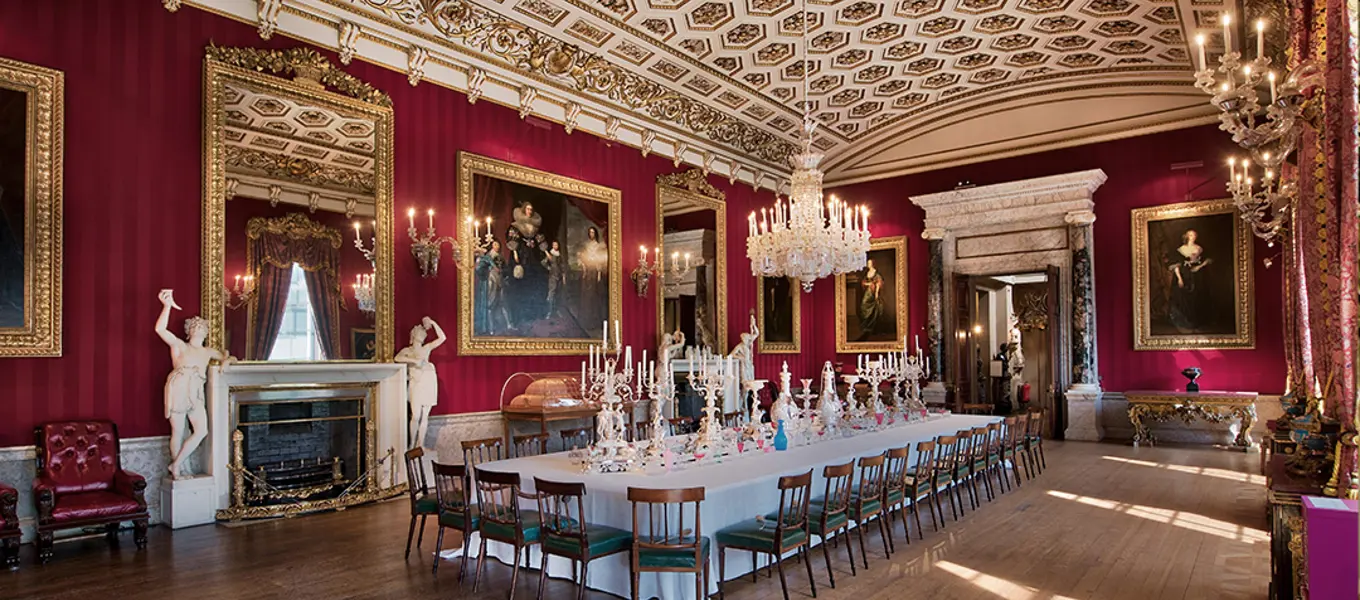The Great Dining Room was used by the family whenever there were more than six people for dinner until the outbreak of World War II in 1939. Today it is used for a few exclusive formal dinners each year of up to forty people.
The first dinner to have been held was for Princess Victoria and her mother the Duchess of Kent in 1832. Victoria was 13 years old and it was the first time she had dined formally in adult company. The 6th Duke was so anxious that it should go without fault that he held a full cooked rehearsal the night before.
The table is furnished with a surtout de table of silver. The two bottle-shaped containers were made by Anthony Nelme (c.1672-1722) for the 3rd Earl of Burlington. The rest of the silver was commissioned by the 6th Duke from Paul Storr (1771-1844) and Robert Garrard (1793-1881), the country’s leading silversmiths in the early 19th century. The surtout is a feature of dining à la Russe, the practice of dining with separate courses brought to you by a butler or footman, which was newly fashionable at this time.
The full-length portraits were all brought from Devonshire House by the 6th Duke and set into fixed frames as part of the decoration of the walls. The large group portrait between the fireplaces shows Christian Bruce, Dowager Countess of Devonshire, with her sons, William and Charles, and her daughter, Anne, painted by Daniel Mytens (c.1590-before 1648).
The eldest boy, on the left wearing the robes of the Order of the Bath, is the young 3rd Earl of Devonshire who was later painted by Sir Anthony van Dyck (1599-1641). That painting hangs to the right of the fireplace. Perhaps the finest portrait in the room is the van Dyck of Sir Arthur Goodwin to the right of the door from the Dome Room. Between the windows are two early portraits by Frans Hals (1581-1666).
With the exception of the curtains and carpet, the room was originally conceived as a white and gold interior. The present red wall hangings were put up in 1996 at the same time as the original silk brocade curtains were rewoven. The chandelier and wall lights were added to the room in the 20th century.

Explore more...
Painted Hall
Used to welcome and impress guests, this was the largest and grandest room built by the 1st Duke.
Oak Room
This room was completely changed by the 6th Duke with the wood panelling he bought at an auction.
Chapel
This is the least changed room at Chatsworth, the 1st Duke employed the best artists to realise his designs.
State Drawing Room
The second room of the State Apartment, a suite of rooms intended to host a king.
State Bedchamber
One of the most private rooms in the State Apartment, this room was more lavishly decorated than all the others and features the State Bed.
Old Master Drawings Cabinet
This room was designed to display Old Master Drawings.
North Sketch Gallery
The North Sketch Gallery, created in 2009, showcases contemporary art and ceramics.
Oak Stairs/Leicester Landing
The stairs were created when the 6th Duke added the North Wing. They connected the old part of the house to the new.
Library and Ante Library
There are over 17,000 books in these two rooms. The whole Chatsworth book collection numbers around 40,000 volumes.
Sculpture Gallery
Built by the 6th Duke, the gallery contains one of the foremost early 19th century contemporary collections of sculpture.
History of Chatsworth
Learn about the Devonshires and discover how they shaped the history of the house, garden and collection that we see today.
History of the garden
The garden evolved over nearly 500 years. Discover its history and the people who shaped it.
The Devonshire Collections
Discover highlights from the art, library and archive that make up the Devonshire Collections.
The House
Learn more about what's on in the house.



